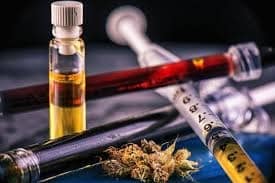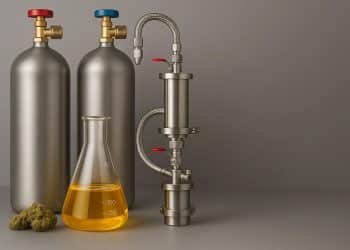Butane, supercritical CO2, and ethanol are widely considered the top three extraction methods. That, however, doesn’t go to say they don’t come without limitations, and we’ve yet to see the ultimate extraction process which is completely well-rounded, and unanimously better than all the rest.
For now, individuals are to decide for themselves which method works best for their particular needs, goals, tastes, resources, time, skills, and knowledge.
Butane Extraction
While butane extraction has gained popularity for providing diversity amongst cannabis concentrates and preserving the cannabis’s native terpene profile, it has gained even more notoriety for the risks it poses, especially for those still attempting it at home. In fact, some of butane’s bad rap for blowing things up has rubbed off on the practice of cannabis extraction as a whole.
Furthermore, there’s some stigma surrounding this extraction method regarding potential butane left in the end product, which is clearly not desirable either. This concern is being mitigated by implementation of more and more robust testing standards being enforced.
Ethanol Extraction
Ethanol extraction might have the most avid supporters, and its good reputation is generally well deserved. In terms of cannabis extraction, ethanol is often considered “safe” like CO2, and efficient like butane.
However, ethanol’s polarity is one factor that must be considered.It mixes with water and pulls water-soluble chlorophyll and other undesirable biomolecules into the end product. It gives the extract a distinctive, bitter, grassy flavor which isn’t palatable for most consumers.
Furthermore, because ethanol has a much higher boiling point (173.1°F, 78.37°C) than solvents like butane (30.2°F, -1°C), it’s more laborious to remove it when purifying the extract. This is the reason behind the more limited variety of extracts that can come from this extraction method.
In addition, some extractors complain about the post-processing and refinement of products from ethanol extraction for being more energy and cost-demanding. This method is considered to be more suitable for large-scale productions which can better mitigate the arduous aspect of the post-processing stage and make it more practical.
CO2 Extraction
Supercritical CO2 is generally praised for being efficient and toxin-free. While releasing CO2 isn’t environmentally conscious, many extractors “recycle” it, so to speak, recapturing most of it in a loop. Using supercritical CO2 as a solvent, however, requires more expensive equipment that’s safe to run at the high-pressures required by the technique. [1]
Another downside is it can be overly efficient and aggressive, meaning it might also degrade the terpene and cannabinoid profile of the biomass, taking away from its nuance, richness, and depth.
As you can see, comparing extraction methods is like playing rock-paper-scissors – no method is without its limitations. Ultimately, manufacturers need to understand these weaknesses when identifying which types of products they want to create, and employ each method for its respective strengths, some of which are discussed in a parallel article this week on our website.
References
[1] Koby, K., “Solvent vs. Solventless Extraction”, Extraction Magazine, Issue 5, Nov/Dec 2018.













